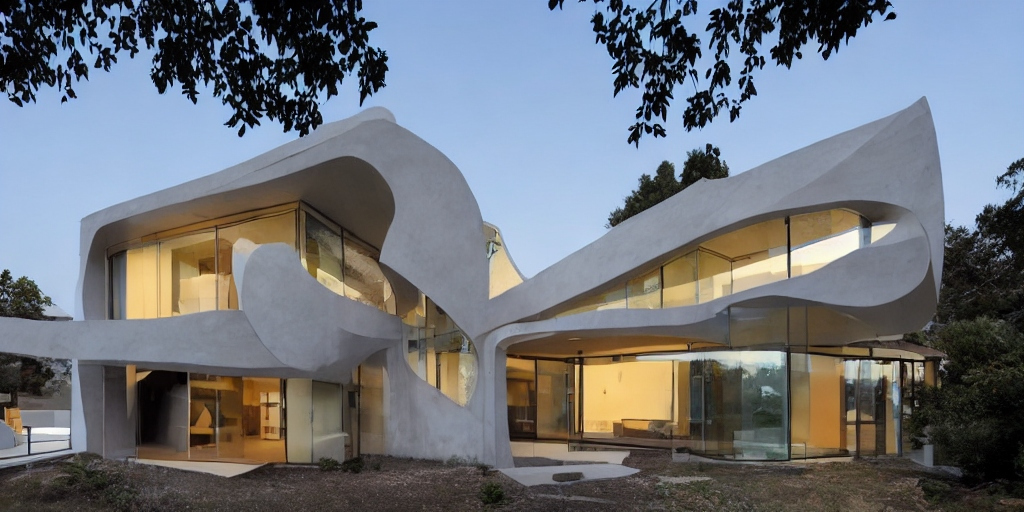Contemporary architecture, a term that sends ripples through the minds of design enthusiasts, isn’t just about buildings—it’s about shaping the narrative of our time. This style, ever-evolving and reflective of present-day trends, consistently pushes the boundaries of what’s possible in the architectural realm.
From the sleek lines of city skyscrapers to the innovative designs of eco-friendly homes, contemporary architecture is a testament to human creativity and technological advancement. In this article, we’ll delve into the captivating world of contemporary architecture, exploring its defining characteristics, influential architects, and its impact on society. So, let’s embark on this journey to appreciate the art that surrounds us in our daily lives.
A Glimpse at Contemporary Architecture
Diving deeper into contemporary architecture unravels a world deeply embedded in functionality, innovation, and aesthetic fluidity. It represents an era of design that values adaptability and sustainability along with visual charm. This architectural style constantly revamps itself, embodying the zeitgeist of each period, creating an engaging dialectic between the past and the future.
Three prominent features characteristically define contemporary architecture. First, open floor plans help foster a sense of spaciousness, inviting light and nature to play key roles in its design. Secondly, it prioritizes minimalism over ornateness, showcasing an appreciation for simplicity and clarity in form and function. Lastly, the use of technology, either in construction processes or embedded within buildings constitutes a focal point, positioning architecture at the fork of design and innovation.
Architects like Zaha Hadid, Rem Koolhaas, and Frank Gehry were instrumental in propelling this style of design. Hadid’s designs, notably the Guangzhou Opera House in China, embody fluidity. Koolhaas’ Seattle Central Library showcases a celebration of geometric variety. Gehry’s transformation of traditional architectural forms into fluid deconstructive designs, evident in the Guggenheim Museum in Bilbao, signaled a whole new direction for contemporary architecture.
Contemporary architecture impacts society in manifold ways. It shapes urban landscapes, making cities more liveable and functional. It can also influence the societal idea of aesthetics, by continually pushing boundaries and presenting unpredicted visual narratives. Moreover, the attention paid to sustainability in contemporary architecture helps preserve the environment, making this style of architecture socially responsible.
Contemporary architecture, with its design philosophies and technological adaptations, holds the promise of shaping our future living environment. Through its melding of technology and design, it embodies a people-friendly, environment-friendly future, painting a holistic picture of architectural endeavors.

Influential Contemporary Architects
Stepping into the spotlight, Zaha Hadid, Rem Koolhaas, and Frank Gehry exhibit the prowess of contemporary architecture. Their ingenuity, combined with a steadfast pursuit of functionality coupled with aesthetics, demonstrates the vision of modern architects. These pioneers have imprinted a significant mark on the global architectonic landscape.
Zaha Hadid, acknowledged for her dynamic designs, charted a unique course in the architectural field. Esteemed projects like the MAXXI Museum in Rome and the London Aquatics Centre for the 2012 Olympics exemplify Hadid’s fluid design language. Her pioneering ideas echo throughout her buildings, accentuating futuristic designs with unconventional geometrics.
Rem Koolhaas, on the other hand, has earned a reputation for challenging architectural norms. His work illustrates a keen understanding of urbanism and culture. Structures like the Seattle Central Library and the CCTV Headquarters in Beijing display Koolhaas’s distinctive architectural approach, integrating technology and transparency.
Frank Gehry, known for his sculptural and dynamic structures, brought a new dimension to architecture. His projects, including the Guggenheim Museum in Bilbao and Walt Disney Concert Hall in Los Angeles, flaunted an orchestrated chaos of shapes and materials. Reflecting a true artist’s spirit, Gehry’s work fused function and form into a harmonious whole.
In essence, these architects represent the transcendence of traditional boundaries, pushing the possibilities of contemporary design. Each of these architects, through their projects, presents an architectural narrative, emphasizing the power and potential inherent in contemporary architecture. Their work underlines the impact of contemporary architecture, setting a benchmark for future generations. With their avant-garde designs, they’ve inspired a global dialogue on the fusion of functionality and aesthetic value in architecture. Consequently, they’ve contributed to the conception of a more dynamic and engaging urban environment.
Prominent Structures in Contemporary Architecture
The essence of contemporary architecture lies not just in conceptual designs but also in significant structures that dot the urban landscape worldwide. Each of these iconic edifices serves as a testament to the progressive vision of their creators while delineating the path of modern urban architecture.
Designed by Zaha Hadid, the Heydar Aliyev Centre in Baku, Azerbaijan, truly encapsulates modern aesthetic sensibilities. This architectural marvel, renowned for its undulating, wave-like structure, amalgamates cultural spaces with conference halls, thereby embodying functionality with unprecedented aesthetic appeal.
Borne out of Rem Koolhaas’s innovative genius, the CCTV Headquarters in Beijing, China, stands out with its unconventional, looped design. Resembling a 3D Möbius strip, this building challenges traditional high-rise architectures. It’s a spectacular example of how Koolhaas’s insightful understanding of urban spaces culminates in a structure reflecting interconnectivity and synergy.
An unmistakable emblem of Frank Gehry’s unique style is the Guggenheim Museum Bilbao, Spain. This structure, with its scintillating titanium sheets and irregularly curved facade, exhibits how Gehry’s sculptural approach to design steps outside conventional architectural confines. It’s a structure constantly engaged in a mimicry of Spain’s rolling landscapes, captivating art and architecture enthusiasts worldwide.
Another creation of Gehry, the Walt Disney Concert Hall in Los Angeles, USA, showcases Gehry’s flair for translating musical movements into breathtaking structural design. The stainless steel exterior, with its interplay of soft curves and sharp angles, mimics the harmonious symphony of a musical performance. The concert hall distinctly symbolizes the merger of form, function, and art form in architectural design.
Structures like these redefine not only cityscapes but also the narrative of contemporary architecture, symbolizing more than just engineering marvels. They underscore the symbiosis of aesthetic artistry, functional innovation, and contextual sustainability in modern palace design, providing concrete analogies, quite literally, of the visionary ideologies of their creators.
Contemporary Architecture and Urban Planning
Emerging from the ideology of contemporary architecture, urban planning presents a revolutionary approach to city design. Architects apply aesthetics, functionality, and innovation in their structures, reshaping the urban fabric. Zaha Hadid, Rem Koolhaas, and Frank Gehry, pillars of contemporary architecture, incorporate these principles into their urban models.
Zaha Hadid, known for her fluid designs, extends her influence to urban planning. By treating the city as an organism, she conceptualizes spaces that flow and interact. Take, for example, her plan for the Kartal-Pendik Masterplan in Istanbul. By creating a network of pathways, green spaces, and structures, she seeks harmony between the environment and urbanisation.
Likewise, Rem Koolhaas’s understanding of urban environments manifests in his plans. His design for the Euralille complex in Lille, France, epitomizes his vision: a seamless integration of transportation, commerce, and cultural spaces. Koolhaas’s urban understanding reimagines the cityscape as cohesive, not merely a collection of independent structures.
Frank Gehry, lauded for his sculptural structures, brings a creative approach to urban planning. His design for the Grand Avenue Project in Los Angeles highlights this mindset. Gehry transforms the area into a vibrant public space, crafting structures that not only function but inspire.
These architects, by pushing the boundaries of traditional design, mould the urban landscape based on their understanding of society and its needs. Each one of them, in their unique way, champions a novel approach to urban planning, shaping cities that reflect the realities of modern living. Their urban planning strategies, enriched by their contributions to contemporary architecture, present a compelling narrative that underscores the potential of design in redefining urban spaces. Through their visionary perspectives, they herald a new era where functionality, aesthetics, and innovation coalesce, continually shifting the silhouette of the urban landscape.

Contemporary Architecture Around the World
Delving into the international panorama, contemporary architecture showcases multifaceted design ideologies and aesthetics across geography. Iconic structures, designed by pioneers in the architectural field, grace the skylines of cities, displaying the profound influence of local culture, technology, and environment on the design.
The United Kingdom, home to the “Serpentine Pavilion” conceived by architectural luminary Zaha Hadid in 2000, offers an illustration of the fluid design and spatial philosophy of the late architect. The Pavilion, with its undulating roof and transparent walls, embraces the surrounding landscape, lending it an airy and futuristic semblance.
Netherlands, known for its innovative urban planning, embraces Rem Koolhaas’s thoughtful designs. His “Netherlands Dance Theatre” integrates the building into an urban context, blurring the boundaries between public and private spaces, adding a dynamic layer to the urban matrix.
Spain’s urban landscape boasts a masterpiece by Frank Gehry: “The Guggenheim Museum Bilbao.” Gehry’s ability to sculpt the built environment with his innovative use of materials and shapes is evident. The silver scales of the Museum shimmer in the sun, its sinuous curves speaking the language of contemporary architecture.
Reminiscing Asian Architecture, China’s embrace of contemporary design comes into focus with the “CCTV Headquarters” in Beijing, a work of Koolhaas and Ole Scheeren. The CCTV Headquarters, with its looped-tower structure, pushes the boundaries of skyscraper design, replacing traditional stacked floors with a continuous loop of horizontal and vertical spaces.
Down Under, Australia too embraces contemporary Architecture with the “Sails Pavilion,” an avant-garde structure by Jørn Utzon in Sydney. This edifice, inspired by the sails of a yacht, epitomizes Australia’s maritime culture and represents the evolving image of architecture in a high-tech era.
Canada too doesn’t fall behind with Gehry’s “Art Gallery of Ontario” blending old and new architectural elements, demonstrating adaptive reuse and innovation in design.
In each geographical context, contemporary architecture takes root, intertwining with cultural narratives, technological advancements, and environmental considerations. Renowned architects like Hadid, Gehry, and Koolhaas leave a lasting footprint on the global architectural scenario with their unwavering commitment to redefining design and functionality, pushing the boundaries of contemporary architecture.
Contemporary Architecture: Pros and Cons
This style of architecture possesses some unique advantages and downsides. The characteristics that elevate contemporary architecture also serve as potential hindrances, depending on the context.
Pros of Contemporary Architecture
- Inventiveness: Contemporary architecture celebrates creativity and pioneering concepts. For instance, the curved design of the Guggenheim Museum Bilbao epitomizes the ingenuity that this style embraces.
- Sustainability: It often prioritizes environmental responsibility. Architects integrate energy-efficient systems and sustainable materials, as manifested in the Sails Pavilion’s solar panels.
- Technological Integration: This style heavily employs modern technology, enhancing functionality and aesthetic appeal. An example is the CCTV Headquarters in China, whose design showcases a complex structural system made possible by advanced engineering techniques.
- Cultural Expression: It provides a platform for architects to communicate cultural nuances. Canada’s Art Gallery of Ontario embodies this, mirroring the multicultural fabric of Canadian society.
- Cost Intensive: The innovative design and advanced technology involved can lead to increased expenses. Zaha Hadid’s Serpentine Pavilion project exemplifies this aspect.
- Maintenance Issues: High-tech systems and unconventional materials may necessitate specialized care. The Netherlands Dance Theatre, known for its complex design elements, may require expert maintenance.
- Design Over Functionality: Sometimes, visual appeal overshadows practicality. While the uncommon form of Gehry’s dancing building draws attention, it may compromise on space efficiency.
- Lack of Uniformity: Some argue that it’s lack of consistency in design principle can lead to a disconnected urban landscape. This debate is ongoing among architecture critics and urban planners.
This comprehensive elucidation conveys contemporary architecture’s dual-edged nature. Societal appreciation for this style varies. It hinges on a multitude of factors, spanning from individual aesthetic preference to financial feasibility and sustainability concerns.
Contemporary architecture, with its blend of functionality and aesthetics, has undeniably left a significant footprint in the architectural landscape. Its impact, driven by the visionaries like Zaha Hadid, Rem Koolhaas, and Frank Gehry, is seen in the proliferation of open floor plans and tech-integrated designs. Despite the critiques and debates, it’s the inventiveness and cultural expression of this style that truly stands out. However, it’s equally important to recognize the challenges it poses, such as high costs and maintenance issues. While the style isn’t universally appreciated, it’s clear that contemporary architecture continues to shape our urban environments, reflecting societal values like innovation, sustainability, and aesthetic diversity. As we move forward, it’ll be interesting to see how this architectural style evolves in response to changing societal needs and preferences.





